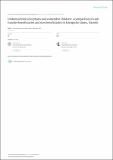| dc.contributor.author | Wakoli, Albert | |
| dc.contributor.author | Ettyang, G.A . | |
| dc.contributor.author | Lakati, Alice | |
| dc.date.accessioned | 2021-08-30T20:15:21Z | |
| dc.date.available | 2021-08-30T20:15:21Z | |
| dc.date.issued | 2012-09 | |
| dc.identifier.citation | Wakoli AB, Ettyang GA, Lakati AS. Undernutrition of orphans and vulnerable children: a comparison of cash transfer beneficiaries and non beneficiaries in Korogocho slums, Nairobi. East Afr J Public Health. 2012 Sep;9(3):132-8. PMID: 23136711 | en_US |
| dc.identifier.other | DOI:10.4314/EAJPH.V9I3 | |
| dc.identifier.uri | http://repository.amref.org/handle/123456789/181 | |
| dc.description.abstract | OBJECTIVE
To assess the prevalence and associated factors for undernutrition among the beneficiaries of Kenya Cash Transfer Program compared to non-beneficiaries in Korogocho, Nairobi. Optimal nutrition reduces the prevalence of undernutrition and contributes to improved child survival and development.
METHODS
A comparative descriptive cross-sectional study design in which a total of 336 children were sampled from the two groups each consisting 168 children. A questionnaire was administered to caregivers. A Food Frequency Questionnaire and a 24 Hour Recall sought information on foods consumed. Anthropometric measurements were taken based on standard procedures. Wasting, underweight and stunting were determined based on a z-score of > or = -2 or < -2 SD. A chi-square test was used to test significance associations of wasting, underweight and stunting with other variables.
RESULTS
A majority (89.3%) and (73.8%) of the principal caregivers were females among the beneficiaries and non-beneficiaries respectively. Among the beneficiaries, prevalence of wasting was 6%, underweight 6% and stunting 32.7%. Among non-beneficiaries, undernutrition was higher with wasting 9.5%, underweight 17.9% and stunting 37.5%. There was a significant difference (chi2 = 11.351, df = 1, p = 0.001) for underweight among the beneficiaries and non-beneficiaries. Nutrient inadequacies were high in vitamin A, folate and zinc in both beneficiaries and non-beneficiaries. In beneficiaries, undernutrition was significantly (p < 0.05) associated with number of children aged 6-59 months in the household, cash transfer used on food, carbohydrate intake, protein intake and frequency of breastfeeding. Among non-beneficiaries, undernutrition was significantly (p < 0.05) associated with number of household members, number of children 6-59 months in the household and income spent on food.
CONCLUSIONS
There was improved nutritional status among the beneficiaries compared to non-beneficiaries. However, there is need of training beneficiaries on the best use of the cash transfers and educating them on consumption of adequate food to improve nutrient intake and eventually their nutritional status. | en_US |
| dc.description.sponsorship | Self Sponsored | en_US |
| dc.language.iso | en | en_US |
| dc.publisher | East African Journal of Public Health | en_US |
| dc.subject | Nutrition | en_US |
| dc.subject | Kenya Cash Transfer Program | en_US |
| dc.subject | Child survival | en_US |
| dc.subject | Anthropometric measurements | en_US |
| dc.subject | Undernutrition | en_US |
| dc.subject | Orphans | en_US |
| dc.subject | Vulnerable | en_US |
| dc.subject | Beneficiaries | en_US |
| dc.subject | Non-beneficiaries | en_US |
| dc.title | Under Nutrition of Orphans and Vulnerable Children: A Comparison of Cash Transfer Beneficiaries and Non Beneficiaries in Korogocho Slums, Nairobi | en_US |
| dc.type | Article, Journal | en_US |

